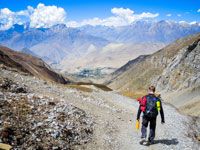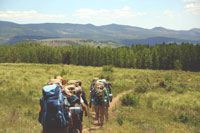

Safe Mountain Hiking
Andrea Boffo explains how to stay safe and injury-free while mountain hiking.
Walking for health. It is not just a saying; It is NHS-approved. All forms of walking, including brisk strolls, cross-country walking, and mountain hiking, our CMO (Chief Medical Officer) recognised activities that can reduce the risk of high blood pressure, diabetes, and heart disease… not to mention hiking is a fantastic form of exercise that works to strengthen the leg muscles while also boosting endurance. It is not surprising to learn that mountain hiking is one of the most popular outdoor activities in the UK.
| However, safety is one huge concern when it comes to mountain hiking. A common question is, 'How dangerous is hiking in mountainous environments?'. According to the Royal Society for the Prevention of Accidents (ROSPA), mountain hiking is much less dangerous than many believe. While 1000 accidents are reported for every 100 million hours of walking, ROSPA notes a much higher 7000 for cycling and an even greater 10,000 per 100 million hours for horse riding. |  |
Despite mountain hiking's apparent safety compared to other sports and activities, it is essential to remember that accidents can—and certainly do—happen. And these incidents are becoming increasingly commonplace. According to statistics published by the British Mountaineering Council, mountain rescue incidents increased from just 45 in 1964 to more than 3000 in 2001. Hikers must ensure they remain happy and healthy on the mountain.
Minimising the Risk of Injury
| So, how should sports coaches advise their clients on minimising the risk of injury on the mountain? Many ways can be taken to ensure overall mountain climbing safety; perhaps the most effective approach is to focus primarily on the most common forms of injury. According to a report by Mountain Rescue England, falling is the most common cause of injury for mountain hikers. In this instance, 'falls' includes slips, trips, stumbles, falls, and tumbles. |  |
Clothing Considerations
It highlights just how important it is for sports coaches to advocate for wearing the correct footwear. The problem, of course, is that there is no such thing as standard mountain hiking boots, with different gear required for different environments, abilities, and other weather conditions. Consider, for example, the significant differences between low-cut hiking shoes, which tend to be ultra-lightweight, and high-cut backpacking boots, which offer greater ankle support and stiffer midsoles.
Similarly, sports clothing must be considered, as wearing the correct clothing can significantly help minimise the risk of injury when mountain hiking. When sun exposure poses a threat, lightweight, breathable fabrics with long sleeves are an essential kit for hikers. It is often advised that mountain hikers browse for sports clothing deals to ensure they have a variety of suitable clothing available to match both the walking route and the conditions on the day of the hike.
Medical Considerations
The second most common cause of injury to mountain hikers after falls is medical collapse and illness. Hikers should prioritise packing any necessary medications and taking them as required throughout the hike. It is also imperative to remain well hydrated, eat small, frequent meals comprising high-calorie snacks, and rest regularly. Most importantly, if a hiker feels unsure about continuing the route, returning to base is best.
Further Aspects to Think About
While having the correct clothing and prioritising personal health are the two most essential considerations for minimising the risk of injury when mountain hiking, there is much more to consider when it comes to staying safe. Here are four further aspects that should be taken into consideration.
Why Take a Hike?
If hikers decide not to participate in a planned mountain hike, they should not be forced into doing so or feel they are required to do so. A loss of interest in the once-favoured activity is remarkably common in sports and, in many cases, will prove to be a temporary state of mind. However, even a temporary loss of interest can result in a loss of motivation to prioritise safety and take the necessary precautions on the mountain, increasing the chance of injury and the need for rescue.
Social Hiking
| For many, mountain hiking is a solitary activity. However, for hikers new to mountain environments or unsure about hiking alone, hiking with a coach, partner, or group can make walking a much safer event. It all comes down to understanding the importance of teamwork and acknowledging that hikers have a responsibility to themselves and others. Open encouragement, support, motivation, and knowledge sharing can go a long way. |  |
Ensuring Readiness
Attempting a challenging mountain hiking route without ensuring that the body is prepared for the degree of difficulty, the particular terrain, and the duration of the walk can easily result in injury. Hikers should always keep their muscles primed and ready for the challenge. While building up to a mountain hike with a series of shorter walks is often recommended, where time proves to be an issue, it can be beneficial to set up a budget home gym, focusing on equipment to strengthen the lower limbs.
Recognizing Improvement
Recognising improvement is an essential skill for all sportspeople of all abilities. However, in terms of safety specifically, perhaps an even more critical skill is acknowledging—and being content with—a lack of improvement. Improvement will occur naturally as a person participates in mountain hiking. However, trying to improve rapidly may result in attempting routes beyond current ability, increasing the risk of injury. Hikers should challenge themselves sensibly.
Conclusion
Mountain hiking can be a very beneficial, challenging, and enjoyable sport. However, with uneven terrain, variable weather conditions associated with changing altitude, and the possibility of poorly defined paths, this sport can also be dangerous. Fortunately, there are many ways that mountain hikers can minimise the risk of injuries, such as wearing appropriate footwear and clothing, prioritising their health, and understanding more about their motivations and physical abilities.
Page Reference
If you quote information from this page in your work, then the reference for this page is:
- BOFFO, A. (2019) Safe Mountain Hiking [WWW] Available from: https://www.brianmac.co.uk/articles/article394.htm [Accessed
About the Author
Andrea Boffo is the CEO of PlusVoucherCode, a website that provides discount codes to save money on online purchases.